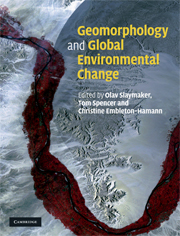Book contents
- Frontmatter
- Contents
- List of contributors
- Preface
- Acknowledgements
- List of acronyms and abbreviations
- 1 Landscape and landscape-scale processes as the unfilled niche in the global environmental change debate: an introduction
- 2 Mountains
- 3 Lakes and lake catchments
- 4 Rivers
- 5 Estuaries, coastal marshes, tidal flats and coastal dunes
- 6 Beaches, cliffs and deltas
- 7 Coral reefs
- 8 Tropical rainforests
- 9 Tropical savannas
- 10 Deserts
- 11 Mediterranean landscapes
- 12 Temperate forests and rangelands
- 13 Tundra and permafrost-dominated taiga
- 14 Ice sheets and ice caps
- 15 Landscape, landscape-scale processes and global environmental change: synthesis and new agendas for the twenty-first century
- Index
10 - Deserts
Published online by Cambridge University Press: 05 July 2015
- Frontmatter
- Contents
- List of contributors
- Preface
- Acknowledgements
- List of acronyms and abbreviations
- 1 Landscape and landscape-scale processes as the unfilled niche in the global environmental change debate: an introduction
- 2 Mountains
- 3 Lakes and lake catchments
- 4 Rivers
- 5 Estuaries, coastal marshes, tidal flats and coastal dunes
- 6 Beaches, cliffs and deltas
- 7 Coral reefs
- 8 Tropical rainforests
- 9 Tropical savannas
- 10 Deserts
- 11 Mediterranean landscapes
- 12 Temperate forests and rangelands
- 13 Tundra and permafrost-dominated taiga
- 14 Ice sheets and ice caps
- 15 Landscape, landscape-scale processes and global environmental change: synthesis and new agendas for the twenty-first century
- Index
Summary
Introduction
Deserts, defined by lack of water and low density of vegetation, cover some 26.2 million km2, or about 20% of the Earth's land surface (Ezcurra, 2006) (Fig. 10.1). Despite their geographic extent, there are few and very limited discussions of the effects of future climate change on desert regions as part of the IPCC process (e.g. IPCC, 2007a).
Most deserts are fragile environments (Plate 25), easily affected by natural and human disturbance, and are being impacted by a rapidly growing and increasingly urban population, which is dependent on scarce surface and groundwater. The importance of water to human and natural systems in deserts makes them very sensitive to those changes in climate that affect the amount, type, timing and effectiveness of precipitation. The rich record of past climate changes in desert regions indicates the magnitude of their amplitude and duration as well as their effect on land-scapes and ecosystems and allows the assessment of the nature and effects of future climate changes.
Hydroclimatological observations show that changes in seasonal and annual temperature, precipitation, snow-melt and runoff, groundwater recharge and evapotranspiration are occurring today in most deserts (e.g. Dai et al., 2004; IPCC, 2007a) and models predict that they are likely to continue in the future. Many areas are already experiencing significant increases in temperature and a reduction in rainfall over the past two decades, manifested in extended droughts, as in the Colorado River basin since 2000; Australia from 2001 – 07 (with especially severe drought in 2002 – 03); Southern Africa from 2001 to 2004; Iraq in 2008; and in Afghanistan from 1998 to 2005. These changes will have significant geomorphic impacts, including changes to the fluvial regime, dust storm frequency and the mobility of sand dunes (Goudie, 2003).
- Type
- Chapter
- Information
- Geomorphology and Global Environmental Change , pp. 276 - 296Publisher: Cambridge University PressPrint publication year: 2009
- 2
- Cited by



